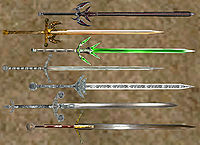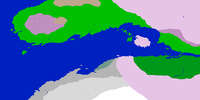Lore:Highland Bretons
The Highland Bretons are a Breton culture believed to inhabit highland strongholds,[1] and renowned for the invention and usage of claymore.[2] They were pioneers in employing these formidable two-handed swords. However, the Redguards later would quickly incorporate these massive shock weapons into their valiant melee tactics. Designed for use by solitary hero-adventurers rather than close-order troops, their claymores were favored in encounters with formidable beasts and otherworldly creatures.[2]
There are a number of highland areas in High Rock, typically composed of woodland hills.[3] The windswept plateau of North Kambria has many grim fortifications and small towns tucked into the folds and valleys that wind their way down to the northern coast.[4] Remote highland regions include the Glenpoint Foothills[5] and the Dragon's Toe of the Wrothgarian Mountains, near the border with Hammerfell.[3][UOL 1] Witches and medicine men, barely distinguishable from Orcish shamans, hold sway over the superstitious peasants of these highlands with feats of untutored, but often impressive, magical ability.[4] Jehanna is also found near a highland area of the province.[6]
History[edit]
Little is known about their role in the history of High Rock, though the rugged highland strongholds and isolated valley settlements of the province have encouraged the fierce independence and contentious tribal nature of the various local Breton clans.[1][4][7] Their culture was already active during the Late Merethic Era, as Bretons were already forging claymores, such as the legendary artifact Chrysamere, during that period.[8]
Many highlands forts are remnants of the constant warfare that have been the scourge of the province. In the past, each petty lord, secure in his castle, enriched himself with tribute from all who traversed his domain, a circumstance considered incompatible with the free flow of commerce. Tiber Septim had begun a program of demolition of these myriad fortresses as a policy meant to facilitate prosperity while removing a potential refuge for subversives.[4]
Their contribution to the invention of the claymore was remembered, with blacksmiths acknowledging it as late as 3E 427.[2]
Notes[edit]
- In the iteration of Arena which would have included Arena teams, Wayrest's team was named the Highlanders.[UOL 2]
See Also[edit]
References[edit]
- ^ a b Provinces of Tamriel
- ^ a b c Garothmuk gro-Muzgub's dialogue in Morrowind
- ^ a b Climate map of Iliac Bay
- ^ a b c d Pocket Guide to the Empire, 1st Edition: High Rock — Imperial Geographical Society, 2E 864
- ^ Daggerfall Region Numbers
- ^ Arena terrain map
- ^ High Rock dialogue option in Morrowind
- ^ Loremaster's Archive - Infinite Archive — Master Malkhest
Note: The following references are considered to be unofficial sources. They are included to round off this article and may not be authoritative or conclusive.
|
||||||||||||||||||||||||||||||||||||||||||||||||||||||||

